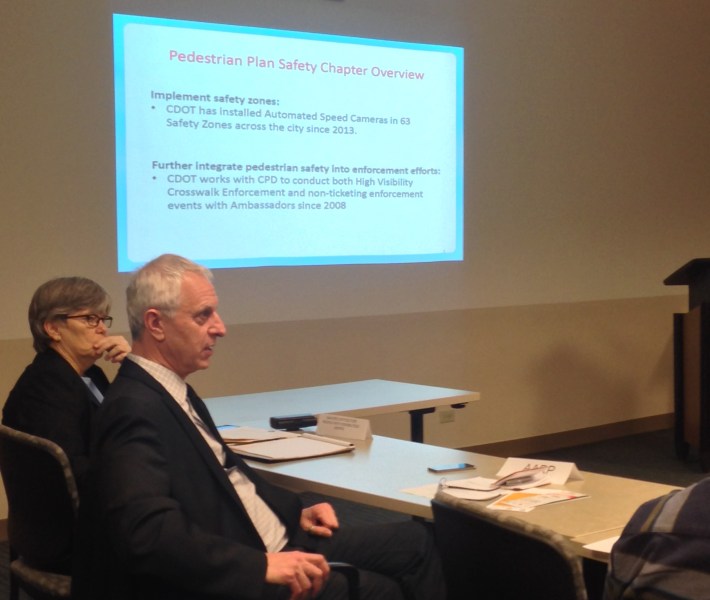Chicago Joins Vision Zero Network While Pedestrian Fatality Rate is in Flux
2:20 PM CST on February 4, 2016

At yesterday's quarterly meeting of the Mayor's Pedestrian Advisory Council, Chicago Department of Transportation commissioner Rebekah Scheinfeld mentioned the "somber" statistics that there was a significant increase in Chicago pedestrian fatalities in 2015 compared to previous years.
There were 35 pedestrian deaths in the city in 2014, according to official Illinois Department of Transportation figures, and 46 fatalities in 2015, according to unofficial figures from the Chicago Police Department – a 24-percent increase. IDOT data for 2015 won't be available until the fall.
"This is still a decrease if you look at the 10-year trend," Scheinfeld said. "We are headed in the right direction for the long-term trend, but we still have our work cut out for us."
As part of Chicago's effort to eliminate traffic deaths, last month it was announced that the city would be joining the Vision Zero Network as one of ten focus cities this year. "Each focus city will have a multi-departmental effort," Scheinfeld said at the MPAC meeting. "We will have reps from the Chicago Police Department, CDOT, Department of Public Health, and the Mayor's Office."
"Vision Zero is an international traffic safety movement guided by the principle that no loss of life on our streets is acceptable," explained Active Transportation Alliance campaign director Kyle Whitehead in a blog post last week.
Nearly a year ago, the group noted that Chicago had already created several resources for analyzing what's causing crashes throughout the city and determining how they can be prevented, including the Chicago Pedestrian Plan, the Streets for Cycling Plan 2020 and Chicago Forward Action Agenda. However, they noted that there was no Vision Zero action plan at the time – which is still true today.
Scheinfeld noted two trends that CDOT has seen among last year's pedestrian fatalities. Despite the growing number of speed cameras in the city, she said "we still saw a significant amount" of pedestrian fatalities "hit by motor vehicles that were moving at excessively high speeds." And more than half – 56 percent – of the deadly crashes occurred in or very near intersections.
The commissioner credited speed cameras for reducing crashes and injuries near parks and schools. She said that in locations where cameras were installed in 2013, there were 18 percent fewer injury crashes in 2014, compared to only a four percent reduction citywide. The total number of crashes in 2014 at locations with speed cameras fell two percent, while crashes were up by six percent citywide.
Deputy commissioner Luann Hamilton said that speeding violations dropped an average of 53 percent in the first 90 days after camera installation, and that most vehicles issued a citation aren't cited again. "So [drivers are] learning from having this violation imposed on them," Hamilton said. "That's the intention in the first place, to teach people it's not acceptable to speed."
CDOT pedestrian program manager Eric Hanss shared his analysis of pedestrian crash and injury data for the ten-year period of 2005-2014. "When we look at the ten year [interval, pedestrian crashes are] down, but when we look at five years, it's flatter."
Hanss said that nowadays in Chicago, fewer than 3,000 pedestrians are struck annually, and the decline in pedestrian crashes is occurring at a faster rate than the city's overall decline in crashes.
Because people on foot are more likely to die if a crash occurs than any other type of road user, CDOT is focusing its efforts on reducing pedestrian crashes, Hanss said. Fourteen percent of pedestrians involved in collisions are seriously injured or killed, compared to only 1.2 percent of all people involved in crashes.
Hanss said 65 percent of pedestrian crashes occur within 50 feet of an intersection. Among crashes where the pedestrian's actions at the time of the crash are known, in 46 percent of the cases the pedestrian had a walk signal. "We don't have pedestrians who are just jumping out into traffic," he said.
Charlie Short, who manages CDOT's Bicycling and Safe Routes Ambassadors program noted that the ambassadors partner with police officers to do outreach to motorists about pedeestrian safety laws. For example, they inform drivers of the state law that requires them to stop for pedestrians in crosswalks.
"I'm curious to see how that works, because I don't experience that," said Bob Gallo, the Illinois director for the American Association of Retired Persons. "I see a lot of rule breaking, and a lot of motorists in crosswalks." He said he walks to work downtown and hasn't noticed any improvement in driver behavior over the years.
"It's my observation that red light running is epidemic," Gallo said. "If red light running was a disease, the [Centers for Disease Control and Prevention] would quarantine Chicago. I know the police are doing the best they can, and other jobs they have are more of a priority." He suggested that red light camera locations be chosen based on the amount of foot traffic at an intersection, in addition to the number of crashes.
Short also discussed a new Safe Routes for Seniors program that CDOT piloted last fall. The ambassadors visit senior centers to talk with residents about their safety concerns. He said they are trying to connect seniors with services that are already available, by informing them about how to report issues to 311, reach out to elected officials, use transit and paratransit, and design safe routes to places they need to visit.
Stay in touch
Sign up for our free newsletter
More from Streetsblog Chicago
Today’s Headlines for Thursday, April 26
The de-facto ban on riverwalk biking is back. What should we do about it?
In the short term, new signage is needed to designate legal areas for cycling on the path. In the long term CDOT should build the proposed Wacker Drive protected bike lane.


